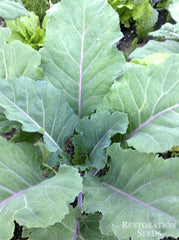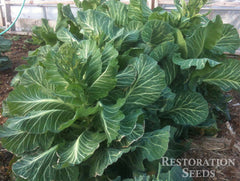Georgia Southern
HOW TO GROW COLLARDS
Start indoors 4-6 weeks before last frost, plant out 3 weeks before frost. For fall harvest, transplant 13 weeks before first frost, without additional protection. In a hoophouse, you can plant 2-3 weeks later. Harvest from the bottom of the stem up. Will over winter in most areas. Collards are most tender and delicious after frost. Waxy leaf surface reduces cabbage worms, row cover at transplant if needed. Harvest leaves from the bottom up, cool quickly, dunk in cold water to wash, store at 32˚F. Soil pH 5.0-8.5. Hardiness zones 7. Biennial.
Days from maturity calculated from the date of seeding. Average 7,000 seeds per ounce. Average 112M seeds per acre. Federal germination standard: 80%. Usual seed life: 5 years. Isolation distance for seed saving: 1 mile.
Planting Depth 1/4-1/2”
Soil Temp. Germ. 50-75˚F
Days to Germ. 3-10
Plant Spacing 12-18”
Row Spacing 24-36”
Days To Maturity 65–70
Full Sun, Moist Well Drained
Days from maturity calculated from the date of seeding. Average 7,000 seeds per ounce. Average 112M seeds per acre. Federal germination standard: 80%. Usual seed life: 5 years. Isolation distance for seed saving: 1 mile.
Planting Depth 1/4-1/2”
Soil Temp. Germ. 50-75˚F
Days to Germ. 3-10
Plant Spacing 12-18”
Row Spacing 24-36”
Days To Maturity 65–70
Full Sun, Moist Well Drained
Georgia Southern Seed Count
1 Ounce ≈ 8,100 seeds
.25 Pound ≈ 32,400 seeds
1 Pound ≈ 130m seeds
- 200 Seeds$4.10
- 1 Ounce$18.00
- 1/4 lb$48.00
Heirloom collard released around 1880, tender, mild and juicy. Large non-heading plant grows 2–3 feet with cabbage-like flat, blue-green leaves. Hardy, heat and color resistant, harvest into snow, tolerates poor soils. Produces through the winter in temperate climates. Also known as Creole collards. Tags: Color: Blu...
Heirloom collard released around 1880, tender, mild and juicy. Large non-heading plant grows 2–3 feet with cabbage-like flat, blue-green leaves. Hardy, heat and color resistant, harvest into snow, tolerates poor soils. Produces through the winter in temperate climates. Also known as Creole collards. Tags: Color: Blue Green, Specialty: Bolt Resistant, Heritage: Heirloom, Season: Summer
Learn More
Reviews




